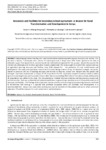| dc.description.abstract | Integrating agriculture teaching with rural transformation and development requires resources and facilities. This has been a beacon, a philosophy and a mission of school agriculture in Kenya since 1959. School agriculture has had an elaborate support from government, community and international donor agencies for this purpose. Despite the support, the mission and philosophy and of school agriculture remains unattainable. The study sought to establish the provision and use of agriculture teaching resources and facilities since 1959 relevant for the promotion of rural transformation and development. The study used qualitative research with historical design in determining the historical strategies and polices related to provision and use of teaching resources and facilities to describe, analyze and interpret how the policies and strategies have been implemented. A sample of 119 respondents from26 purposively sampled secondary schools in which agriculture was taught was used to provide relevant data. Due to snowballing effect extra 17 secondary schools yielding extra 46 respondents was added to the study. The instrumentation included interview schedules and documentary sources and archival searches. Data was synthesized and analyzed qualitatively by generating a narrative account of acquisition and use of resources and facilities. The findings of the study show that the provision and use of agriculture teaching resources has failed to demonstrate that farming is a dignified and profitable occupation which can stimulate rural development. It is recommended that relevant and sustainable teaching resources be marched with the syllabus and use to reflect curriculum objectives. This will be a beacon for rural transformation and development. | en_US |

